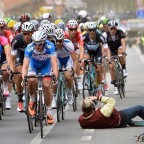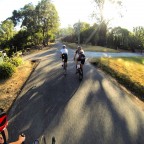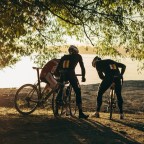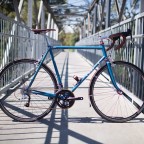Photo: Shane Goss/www.licoricegallery.com
This past Saturday was my first race back after a few months off. Thankfully it wasn’t the fierce crosswinds and sheets of rain like Melbourne has been getting recently. It was sunny and a bit cold, but as my grandmother always said - “there’s no such thing as cold weather, just inappropriate clothing!”
I’m not telling you anything new by stating that bike racing is chess on wheels. One move that goes up the road will elicit a completely different reaction from the peloton than a another move. Unfortunately not everyone is familiar with the tactics that are at play which can cause confusion, senseless bickering, and irrational riding. As I said in a post last week, the could also be other arrangements that were made where riders who don’t appear to be working together could be in alliance.
One thing that will help you the immensely in bike racing is knowing your opponents. If you know who is good at what and who is helping who, this will enable you to read the race much more effectively.
In The Peloton
When a small group breaks away and you are left sitting in the peloton you need to be aware of who is in that group up the road. There’s a good chance that the teammates of those break-away riders will be sitting at the front riding a false tempo (just hard enough to appear not to be blocking but soft enough so that the break-away will be pulling away). Don’t expect them to help chase down the break. Why would they? One of their riders is up the road who has a shot of winning.
The only riders who have a responsibility to actively chase down that break are the ones who don’t have a teammate up the road. If it’s a large break there may be no one who is willing to chase it back. Many times if you decide to take the chase upon yourself the only thing that you’ll be achieving is helping someone else win the race. By the time you catch the break you’ll be too shattered to give 100% when the counter attacks come.
However, many races at the amateur level are not made up of “teams” per say, but “alliances”. These alliances are much more difficult to distinguish but if you pay close attention you’ll be able to see who has interests at stake and get a rough idea of who is working with who. For example, if there’s a guy trying to block at the front or is messing up the tempo of the chase, it’s probably a good indication that he wants that break to stay away.
Don’t forget about the sprinters left in the peloton. These are the guys who are most comfortable when things get sketchy at the end and are okay with waiting to see how things pan out. You should never rely on a sprinter to do any work as the only thing he’s thinking about is getting over that next hill and the final 200 meters. He knows that if he uses more energy than he needs there are other sprinters in the pack who are doing nothing who will roll him at the finish. Yes…this is a glimpse into the mind of a sprinter.
In The Break
Just because you made the break doesn’t mean that you’re home-free until the finish line. There may be riders sitting on the back not willing to do anything. This may be because they have a gun sprinter sitting in the peloton and would be just as happy having things come down to a bunch sprint. Alternatively, if the break succeeds he’ll have fresh legs for the finish. It’s a no-lose situation for this guy so he doesn’t necessarily need to do any work. However, it’s rare that someone is that dedicated to his sprinter that he’ll forgo his own aspirations for the win. This guy can be pressured to work with you.
There could also be multiple riders in the break who are working together and some are the dedicated work horses. Watch closely to see who is trying to pressure the guy(s) not working in the break and you’ll get an idea of who is teamed up. For example, I’ve been in many breaks where our sprinter also makes it across with me. That means that I’ll be picking up the workload so that our sprinter has fresh legs for the finish. Riders will try to pressure him to do work, but he’s not obligated to. If the group swallows us up, he’ll be just as comfortable in that situation. Those damn sprinters have it so easy…
There may also be guys who made the break but got in way over their head. After 10 minutes of hard riding they’re completely smashed and can only sit on the back. You can tell by their body language if they’re truly spent or not. You don’t really want someone like this helping out as they’ll just disrupt your paceline. It’s better to let that person sit on until the end. If he has any dignity whatsoever he won’t roll you at the finish. I have to admit that did this once and have felt ashamed about it ever since (apologies to Dylan Newell). Fortunately it was a reverse handicap and I didn’t end up winning even though I crossed the finish line first (huh?).
2 on 1
If you’re left with a 2 on 1 situation and the finish line is near it doesn’t necessarily mean that you’ve lost. Quite the contrary. There’s a way to make it work for you, and there’s a way to make it work against you - it all has to do with positioning. I’ll touch on the tactics of this next week. Peter MacDonald beat Michael Rogers and Adrian (oops) Adam Hansen (both on HTC-Columbia) to win the Nationals this year simply by positioning himself properly.
Against All Logic
One thing to keep in mind is that there are many riders new to the sport who are still learning the intricacies of racing. They will do things that go against common sense and are completely unexpected. This will never go away so it’s good to be wary of. You don’t need to over analyze every move in the race. Everyone has to start somewhere so you gotta cut these guys some slack. Even the pro riders make bonehead tactical moves sometimes.
The other thing that will disrupt logical thinking are the riders in the pack considering it “training”. There are always some guys wanting to be out there simply to get a hard work workout in which can completely mess things up. A word of advice to these people - racing is for racing, training is for training. You wouldn’t go out and play footy and kick the ball in every which direction and score on your own goal just because you wanted go for a jog would you? Sure you can come to a race to get some hard riding in, but it will make it much more enjoyable for everyone if you stick to the game.















Pingback: investment managers